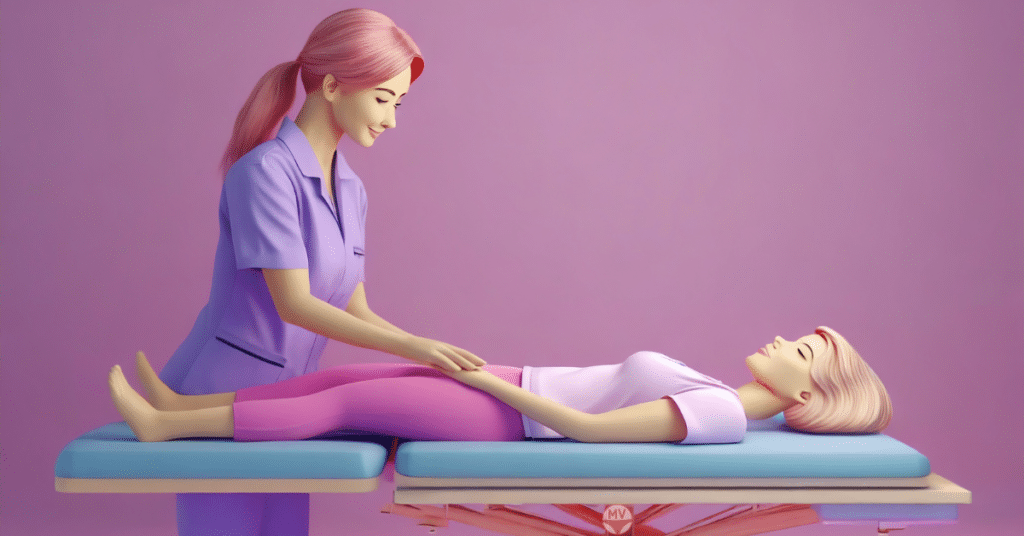Osteopathy can offer sometimes significant relief from pelvic conditions, from endometriosis to pelvic floor dysfunction. Seeing an osteopath for pelvic complaints can be, at the very minimum, a good way to be assessed and have any niggles straightened out.
Some people with chronic pelvic problems, like pain or dysfunction, may need ongoing treatments to find relief. The combination of an osteopath with other health practitioners may be a helpful approach in some cases.
What is an osteopath?
An osteopath is a health professional who primarily works with the body’s structures. Muscles, ligaments, tendons, bones, nerves, joints, organs, circulation and soft tissue are manipulated in gentle, effective ways to ensure the body is sitting and functioning as it should. That is, as one big functional unit.
There are many approaches to this, such as stretching, massage, and manual manipulation of ligaments and joints, exercise therapy, equipment, and lifestyle advice.
Osteopaths are highly trained health practitioners who perform unique assessments and treatments of the body.
Osteopathy and pelvic problems – understanding the pelvic floor
The pelvis is connected to every part of the body in various ways, for example, our digestive tract runs the full length of our torso. The pelvic floor muscle group is located as a basin in the pelvis, and attaches to the front, back and side of the pelvic bone and the sacrum (just above the tailbone).
The pelvic floor supports all the pelvic organs – bladder, uterus, rectum – and wraps around the urethra, rectum and vagina. The pelvic floor works to control the bladder and bowel. Your pelvic floor relaxes when you urinate, have a bowel motion, and during sex.
The pelvic floor also relaxes and contracts when you breathe, allowing extra space in your body for your lungs to expand. The pelvic floor is also called the pelvic diaphragm, and it works in concert with the diaphragm in your chest.
Pelvic floor weakness can occur for many reasons, including poor posture, incorrect breathing, and trauma to the tissues (think childbirth). The way we walk and sit can also cause pelvic floor weakness, along with overall muscle tone and connective tissue losses as we age.
Coughing, hormonal changes, straining on the toilet, lifting heavy things, obesity and pregnancy can all contribute to a weak pelvic floor.
An osteopath can help correct this weakness or imbalance, thus relieving many pelvic problems that are caused by improper functioning of the pelvic floor or overall pelvis.
Osteopathic treatments for pelvic complaints
- Pelvic floor exercises
- Exercises for the supportive structures of the pelvis
- Electrotherapeutics
- Manipulation of soft tissue
- Breathing guidance
- Stretches
- Posture
- Managing actions that create downward pressure, like constipation, straining or lifting heavy things
- Massage
- Realignment of pelvic structures
Study1 into osteopathy for endometriosis and pelvic pain
Researchers looked into the effect of osteopathy on women with endometriosis and chronic pelvic pain, with positive results.
Twenty-eight women who had pelvic floor pain and tightness were recruited for the study and received osteopathic treatments. Pain had been present for between one month and 20 years, with 14 of the patients having confirmed endometriosis.
Twenty-two of the 28 women completed the treatment as designed, and 17 of the 22 reported symptom improvement.
Ten of the 14 endometriosis patients reported improvements. The treatments were well-tolerated in women with pelvic floor tightness and can be used as an effective treatment option.
Pelvic floor dysfunction after childbirth
There are varying views in osteopathy on what causes pelvic floor dysfunction after childbirth. Some believe that pregnancy and birth are the primary causes of pelvic floor dysfunction in some people. Others are of the view that if the body is not properly primed prior to pregnancy and birth, the pelvic floor suffers as a result.
The negative impacts of pelvic floor dysfunction are many and varied, but urinary incontinence is a big one. The pelvic floor relies heavily on its surrounding structures for proper function, which means the muscles are the correct length and strength. If the surrounding pelvic floor support structures are not up to scratch, pelvic floor muscles are weakened, tightened, or become dysfunctional as a result.
There is a difference between a tight and a weak pelvic floor, and each person will be assessed individually to see what the body is doing. Appropriate treatments can then be applied.
Pelvic floor exercises
A tight pelvic floor may need relaxing, not pelvic floor exercises to strengthen it, but each of us is different.
Whether you need toning or relaxing is an important element to consider before doing pelvic floor exercises on your own. Strengthening of support structures may be required, so isolating the pelvic floor as your one-stop shop may not be what you really need. See a pelvic physiotherapist or pelvic-specialist osteopath for advice.
Kegel’s are a set of exercises devised to strengthen the pelvic floor muscles, but can result in pulling on the pelvic bones, drawing them inwards, and have a counterproductive effect. The relaxation part of the pelvic floor exercise should be taken into consideration, as it is just as crucial as the strengthening elements, depending on individual circumstances.
Learning how to breathe properly and proper posture are so important when caring for your pelvis, so don’t ignore the whole body as a functional system. Everything is connected to everything else, and how you move around the world matters.
References
- 1.Sillem M, Juhasz-Böss I, Klausmeier I, Mechsner S, Siedentopf F, Solomayer E. Osteopathy for Endometriosis and Chronic Pelvic Pain – a Pilot Study. Geburtshilfe Frauenheilkd. Published online September 22, 2016:960-963. doi:10.1055/s-0042-111010
Get a fresh perspective with a qualified, experienced vulvovaginal specialist naturopath.
This product has multiple variants. The options may be chosen on the product pageThe most comprehensive vaginal microbiome test you can take at home, brought to you by world-leading vaginal microbiome scientists at Juno Bio.
Promote and support a protective vaginal microbiome with tailored probiotic species.







